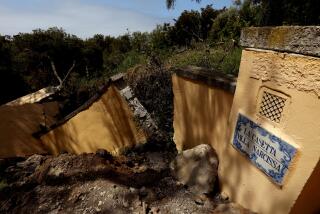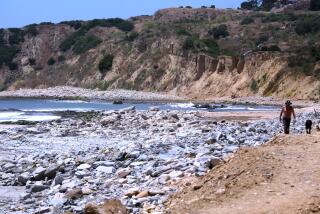A change in the wind threatens giant sand dune : Jockey’s Ridge in North Carolina is shifting to the southwest. It will likely flatten out if costly steps aren’t taken.
- Share via
NAGS HEAD, N.C. — As calamities go, there are worse vexations than waking up one morning to find a pile of sand blowing into your back yard.
But when the pile is more than 100 feet tall and seems to be moving with invasive intent toward your bedroom window, then maybe it’s time to consider moving.
That’s what some folks have begun doing in Nags Head, where a giant sand dune--the largest in the eastern United States--has taken a mind to ramble.
Jockey’s Ridge, as the dune is called, already has swallowed a miniature golf course, is spilling over into people’s yards and threatens to close a road. The state has been keeping the road clear by trucking sand from the leading edge of the dune to the trailing edge. But that is considered only a temporary solution.
A study of the dune’s movement was recently launched by the state Division of Parks and Recreation and is expected to last through most of the year. In the meantime, the state has started buying private property threatened by the sand.
“It’s a living sand dune and it’s going to move,” said George Barnes, the superintendent at the 414-acre Jockey’s Ridge State Park, which encompasses the dune.
What has state officials dumbfounded, however, is why the dune in recent years apparently has started to move relentlessly to the southwest.
Stan Riggs, a geology professor at East Carolina University in Greenville and an expert on sand dunes, believes the movement is not a threat.
“The dune has always moved around,” he said. Unlike dunes in the desert regions of the western United States, which “march like crazy,” Jockey’s Ridge is a “water-bound dune” and so is more or less glued to one spot, he insists. Rather than march, it wiggles, he said. “It spreads out a little bit and then it reforms.”
But state officials aren’t so sure. “Usually sand blows in one direction part of the year and then blows back in the other direction the other part of the year,” said Sue Regier, who heads the park division’s resource management program. But she suspects that development of shopping centers, housing and motels near the dune has altered wind flow enough that the dune’s normal movement patterns have been altered.
Orrin Pilkey, geology professor at Duke University and head of the Program for the Study of Developed Shorelines, agrees that development was carried out without any regard to its possible effects on the dune. He also speculates that natural changes in wind direction may be a factor.
Jockey’s Ridge is a tourist attraction on the string of barrier islands off the North Carolina coast known as the Outer Banks. Each year, more than 800,000 people visit the dune. It is popular with hang gliders who come to soar with the sea gulls.
Once part of a system of dunes that stretched from Virginia, Jockey’s Ridge is one of only two remaining dunes that have not been flattened by development or covered with vegetation.
Jockey’s Ridge barely escaped such a fate. In 1975, when the state park was created, “they were in the process of putting a housing development on it,” Riggs said.
If it is determined that the dune is truly marching in only one direction, then the state will have few options: It can either devise a system to keep moving the sand so that it doesn’t flow onto private property or roads, or it can let nature run its course.
“Neither of the options is inexpensive,” Regier said.
She would not speculate on the cost of hauling the sand away, except to say that estimates of $500,000 are conservative.
The second option--letting the dune blow where it will--would not only mean the state would have to continue buying property in its path, it also would mean the eventual death of the dune, she said.
“If you let it keep moving without sand coming into the system, it will eventually flatten out,” Regier said. Already the dune has shrunk from a height of 138 feet to as little as 100 feet, depending on wind and weather conditions, Barnes said.
Riggs believes the shrinkage is caused by all the tourists and hang gliders who traipse over the dune and blames human encroachment for the perception that there is a problem. For instance, the covered-over miniature golf course was built on the base of the dune, he said. “If you don’t want to be bothered by it, don’t build your golf course there,” he said.
The dune’s movement has become an issue only because of the “greed” of nearby landowners who have sued the state, he said.
“In the old days for the local people who lived out there, it wasn’t a problem,” he said. “As recently as 25 to 30 years ago, they all had dump trucks and a bulldozer in their back yards and they’d just load up the sand and sell it.”
Times researcher Edith Stanley contributed to this story.
More to Read
Sign up for Essential California
The most important California stories and recommendations in your inbox every morning.
You may occasionally receive promotional content from the Los Angeles Times.










